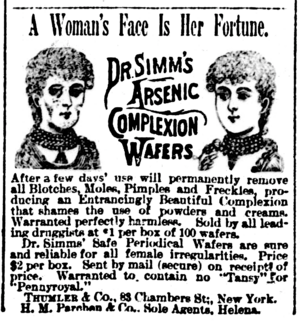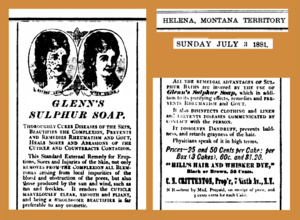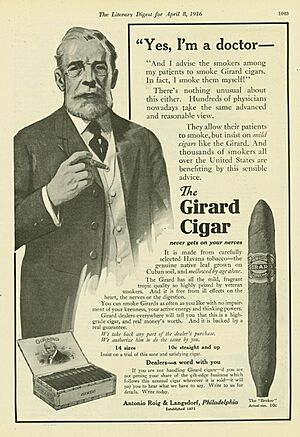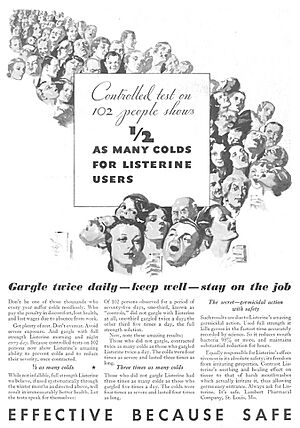False advertising facts for kids

False advertising is when a company uses untrue or misleading information in an advertisement to sell a product or service. This can happen on purpose to trick people, or by accident. When an ad is deliberately misleading, it is called deceptive. Many governments have laws to protect people from false advertising.
Contents
How Ads Can Be Misleading
False ads can trick people in many different ways. Sometimes they contain information that is not true, and other times they are designed to give you the wrong idea.
Making Things Look Perfect
One common trick is using photo editing to make products look better than they are. This is often used in ads for makeup or weight-loss products. By changing a photo, a company can make it seem like their product gives amazing results that are not realistic for most people.
For example, a makeup ad might use an airbrushed photo to make a model's skin look perfectly smooth. This gives a false impression of how well the makeup works.
Hidden Fees and Extra Costs
Have you ever seen a product advertised for a low price, only to find out it costs more? Sometimes companies hide extra fees and charges in the fine print.
Another example is when you buy something online. The price might look cheap, but then you have to pay for high shipping costs at the end. Some hotels also add extra "resort fees" that are not included in the advertised room price.
Not What's Inside the Box
Some companies use tricks with their packaging.
- Fillers: Some food products contain "fillers," which are cheap ingredients used to add weight. This makes you think you are getting more of the main product than you really are.
- Big Packaging: A product might come in a very large box or bag that is mostly empty. This can trick you into believing you are buying more than what is actually inside.
- Misleading Pictures: The picture on a food box might show a delicious meal with extra ingredients that are not included in the package. This is why you often see the words "Serving suggestion" in small print. Also, pictures of toys or furniture might show the item fully built, even though you have to assemble it yourself.
Fake Health Claims
Ads often use words like "healthy," "low-fat," or "sugar-free" to make you think a product is good for you. Companies know people want to be healthy, so they use these labels to sell more.
However, these claims can be misleading. A cereal might say it's "healthy" because it has one healthy ingredient, but it could also be full of sugar. In one famous case, the yogurt company Danone had to pay $45 million in a lawsuit because it falsely claimed its Activia yogurt was scientifically proven to boost the immune system.
Tricky Words and Comparisons
Advertisers are very careful with the words they use.
- Meaningless Words: Labels like "all-natural" are often used on food packages, but they don't have a clear, legal definition and can be misleading.
- Incomplete Comparisons: An ad might say a product is "better" or "faster." But better or faster than what? They often don't say. An ad for a cold medicine might say it's "better," but it could just mean it's better than taking nothing at all.
What is "Puffery"?
"Puffery" is when an ad uses exaggeration or opinions that can't really be proven true or false. Examples include a restaurant claiming it has "the world's best pizza" or a movie being called "the greatest of all time."
Puffery is not usually illegal because it's seen as a statement of opinion, not a fact. No one is expected to take these claims literally. It's a way for advertisers to get attention in a fun way, but it's important to know the difference between an opinion (puffery) and a false claim of fact.
Sneaky Brain Tricks in Ads
Some advertising techniques try to influence you without you even realizing it.
Copycat Brain Cells
Our brains have special cells called mirror neurons. When we see someone do an action, these cells fire up as if we were doing it ourselves. Ads often show people enjoying a product, like drinking a refreshing soda on a hot day. This can trigger our mirror neurons and make us want to do the same thing.
Hidden Messages
Subliminal advertising is when messages or images are shown so quickly that your conscious mind doesn't notice them, but your subconscious mind does. The goal is to make you want to buy a product without you knowing why. Most experts agree that this type of advertising is not very effective, and it is banned in many countries.
Who Protects Shoppers?
Many countries have laws and organizations to protect consumers from false advertising. Their goal is to prevent companies from tricking people, rather than just punishing them afterward.
- United States: The Federal Trade Commission (FTC) is the main government agency that regulates advertising. It can order companies to stop running false ads. States also have their own laws. If a company breaks the rules, it might have to pay a large fine or give refunds to customers.
- United Kingdom: Advertising is regulated by rules that prevent unfair, false, or aggressive practices. Local authorities are responsible for making sure companies follow these rules.
- Australia: The Australian Competition & Consumer Commission (ACCC) makes sure that businesses act according to fair-trade and consumer-protection laws.
- New Zealand: The Fair Trading Act 1986 aims to promote fair competition. It makes it illegal for businesses to mislead consumers.
These organizations work to make sure that ads are truthful and that businesses compete fairly.





